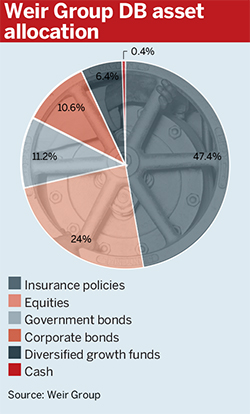Weir Group established a Scottish Limited Partnership with the trustee of its main defined benefit scheme last year, allowing the group to reduce its deficit recovery payments while adding to the security of members’ benefits.
The Glasgow-based engineering company has already taken significant steps to reduce risk across its UK DB arrangements, with nearly half (43 per cent) of total liabilities backed by insurance policies.
Last year, as part of the recovery plan agreed with trustees following the main scheme’s 2014 triennial valuation, the group set up a pension funding partnership structure under which it will make contributions via an SLP.
Pulling harder on the covenant support lever means you can perhaps pull less hard on the cash lever, or seek less investment returns
Jon Hatchett, Hymans Robertson
SLPs are one form of asset-backed funding arrangement in sponsors' toolkit which can be used to transfer assets or capital into a vehicle to provide the scheme with an income or to improve its funding level.
Typically structured over 15-20 years, SLPs protect employers against scenarios where surpluses become trapped within the scheme while also enabling sponsors to reduce the level of annual cash contributions by spreading payments over a longer period.
Reduced contribution rate
As a partner in Weir Group’s SLP, the company’s main UK scheme is entitled to receive a share of the profits once a year for 15 years, subject to certain conditions being met; payments made into the SLP will be reflected in the group’s accounts as a pension contribution. 
This year the group will contribute £2m via the SLP, rising to £3m in 2017 and £4m on an annual basis from 2018 onwards. The total group contributions for 2016, including those expected from the UK SLP, are estimated at £5.8m, a sharp reduction from the £11m paid in 2014.
Jon Hatchett, partner and head of corporate consulting at Hymans Robertson, said the SLP structure has been available to sponsors for five or six years and in some scenarios can be quite an attractive proposition.
However, SLPs are expensive, complex and long-dated structures, Hatchett said, meaning the “benefits of putting them in place have to be worthwhile”.
“There are situations where they do make sense but if there is a simpler approach to solve the funding challenge then that’s generally going to preferable,” he said.
Hatchett said funding a scheme requires a carefully considered combination of cash, covenant support and investment returns.
“What contingent assets, or SLPs, do is they provide another way of giving extra covenant support,” he said.
“Pulling harder on the covenant support lever means you can perhaps pull less hard on the cash lever, or seek less investment returns.”
Providing security
Greater reliance on covenant support can be a better balance for some schemes and sponsors’ risk profile, Hatchett said, enabling a reduction in cash contributions or a reduction in investment risk held across scheme assets.
Ed Hunnisett, senior associate at law firm Norton Rose Fulbright, said SLPs are quite a detailed legal structure to put in place due to legislative restrictions and are typically the reserve of larger schemes.
By and large property is still the favoured asset for use as contingent security, although more esoteric assets have come to market over recent years, he said, adding that trustees should seek independent advice to assess the true asset value.
“If you’re a trustee you want to do sufficient due diligence and get independent advice on the value,” he said.
Where there is deliberation over which contingent structure is most appropriate, Hunnisett said trustees should seek to gauge a “before and after” security position of the scheme to assess what each structure brings to the table.
Sustainable growth
Darren Masters, principal and head of the covenant consulting group at Mercer, said brand names, maturing whisky and cheese have been put into SLPs by UK companies, but a more recent development has been to guarantee security via an internal bond-type structure.
“Rather than having something which is backed by tangible assets, an alternative way of giving group support is to give a group bond which is stuck into the SLP and provides a coupon, [allowing] a slower pace of funding into the scheme,” said Masters.
“Not surprisingly, in circumstances where companies have ploughed lots of money in… over the last few years and haven’t really seen improved levels of funding, if they can get away with paying less over a period of time then that potentially helps with cash flow and the sustainable growth objective.”














